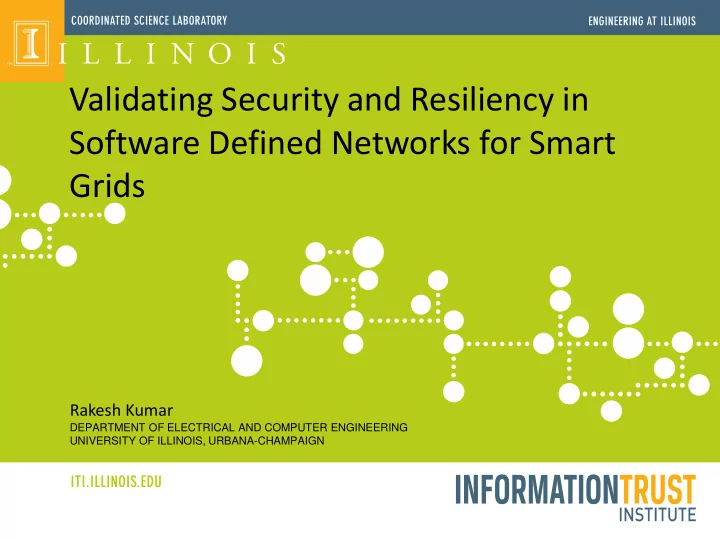

Validating Security and Resiliency in Software Defined Networks for Smart Grids Rakesh Kumar DEPARTMENT OF ELECTRICAL AND COMPUTER ENGINEERING UNIVERSITY OF ILLINOIS, URBANA-CHAMPAIGN
Motivation 2
Security: Access Control • In United States, power utilities are required to follow NERC CIP Standards. – Utilities are periodically audited to secure their Electronic Security Perimeter (ESP) 3
Resiliency: Link/Device failure • Upon failure, ask the SDN controller for flow rules – Applications may not tolerate the delays incurred • Flow rules that anticipate failures and take corrective actions to provide seamless resilience – Fast Failover Mechanism: Designed for small, predictable latency 4
Resiliency: Illustration SCADA Ethernet Controller Relay
Software Defined Networking (SDN) • Logically centralized Control Plane State at Controller • Standardized Data Plane in Switches and Switch- Controller communication protocol. • Controller’s Northbound API enables exhaustive validation. 6
Validation using the SDN Architecture Control Plane State Static Validation Policy Violations Network-wide Policy 7
Rest of the talk: • Life of a packet • Resilient Routing Policy (RRP) Specification • Model • Design • Evaluation • Conclusion and Future Work 8
Life of a Packet in an OpenFlow 1.x switch … • Flow Table Pipeline • Flow Rule – Match – Instructions • Single port output, packet header modifications • Fast Failover Output: {p 1 , p 2 , p 3 … } 9
Resilient Routing Policy (RRP) Specification • Zones: Set of ports • Traffic Set: Packet header field values • Failure Events: Specific set of link/switch failures • Constraints: Desired properties, such as: – Connectivity – Isolation – Path Length – Link Avoidance 10
RRP Example The policy specifies that: • ESR and IED are connected to the RTAC even when any single link fails by a path that traverses no more than three switches in the topology. • The path of HTTPS traffic from the internet to the RTAC must not cross the link between Switch:3 and Switch:4. 11
Model • Efficiency: Emphasis on having the capability to perform incremental computation as events occur in the network Composition: Model for the structure of the • network on different levels of abstraction (i.e. switch and network-level) Explicit Representation: Model for the traffic • (set of packet headers) that flows on the network 12
Port Graph • The state (topology + configuration) of the SDN is modeled as a directed graph. • Nodes model places of interest, e.g. Ingress, Egress nodes for physical ports • • Nodes representing each table • Each edge (p, s) models the transfer of traffic, it has: • Edge Filter: EF(p, s) • Modifications 13
Admitted Traffic Set (ATS) • ATS (p, d) is the set of packet headers that an SDN is able to carry from node p to node d . • T (p, d, s) is the set of packets that are carried from port p to destination d , via its successor s , thus: • Incremental analysis made possible by comparing ATS before and after an event: 14
Design • First, construction of port graphs • Computation of ATS (p, d) for all p, d using a reverse DFS on the port graphs. • Each edge in the port graph has a flag that represents whether the edge is active based on the current state of the network. 15
Constructing Switch Port Graphs 16
Constructing Network Port Graph 17
Initializing ATS (p, d) Destination MAC: 2 Other Fields: Wildcards Source MAC: 1 Destination MAC: 2 Destination MAC: 2 Other Fields: Wildcards Other Fields: Wildcards Destination MAC: 2 Other Fields: Wildcards Destination MAC: 2 Other Fields: Wildcards 18
Evaluation Setup • Experiments performed on a machine running mininet and Ryu : – Two processor cores at 3.3 GHz – 16 GB RAM. • Ten iterations of each analysis 19
Microbenchmark • Flow rules that fast-failover synthesized to sustain failure of a single link • Policy requires that the path lengths be less than the diameter of the network 20
Resilience in a substation network • Same policy as described previously, except the zone sizes keep increasing now 21
Security for interconnected microgrids • Six microgrids connecting to a control center • Network divided in 19 enclaves and a single functional domain • Policy: Communication only possible within an enclave or functional domain 22
Conclusion • A framework for validating resiliency requirements for an SDN by performing exhaustive packet flow analysis • Model, design of data structures • Incremental Computation technique provides computational gains • Scales for larger topology sizes 23
Recommend
More recommend